The word ‘Bahuda‘ in Odia language means ‘Return‘. Bahuda Yatra is the Return Journey of the three chariots to Jagannath Temple. After spending a week inside the Gundicha Temple, the deities commence their Bahuda Yatra on the 10th day. The return journey follows the same protocol and schedule, as is found during the Ratha Yatra.
The magnificent Bahuda Yatra began with a ceremonial procession ceremony known as the ‘Bahuda Pahandi’ in the temple town of Puri. The majestic chariots of the Holy Trinity had been stationed at Gundicha Temple’s Nakachana Dwara, waiting for the deities to return.
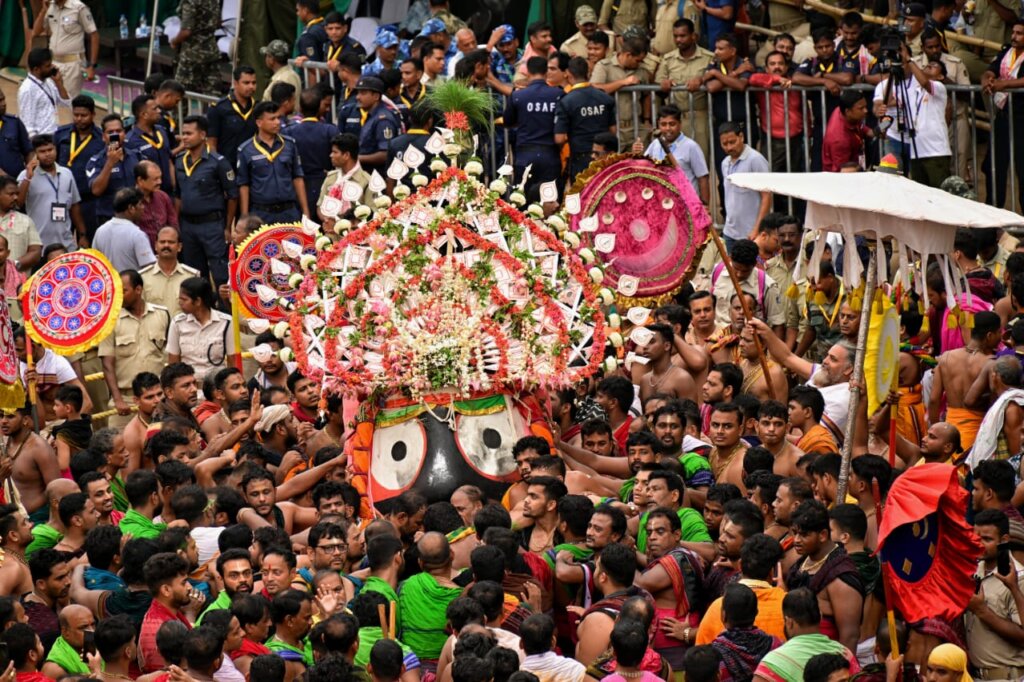
Lord Jagannath and his siblings, Lord Balabhadra and Devi Subhadra, were brought to their separate chariots from Gundicha Temple in a ceremonial Dhadi Pahandi ahead of their return journey to Srimandir on Bahuda Yatra on Wednesday.
The servitors escorted Lord Sudarsan to Debadalana, Devi Subhadra’s chariot, as part of the Dhadi Pahandi rite.
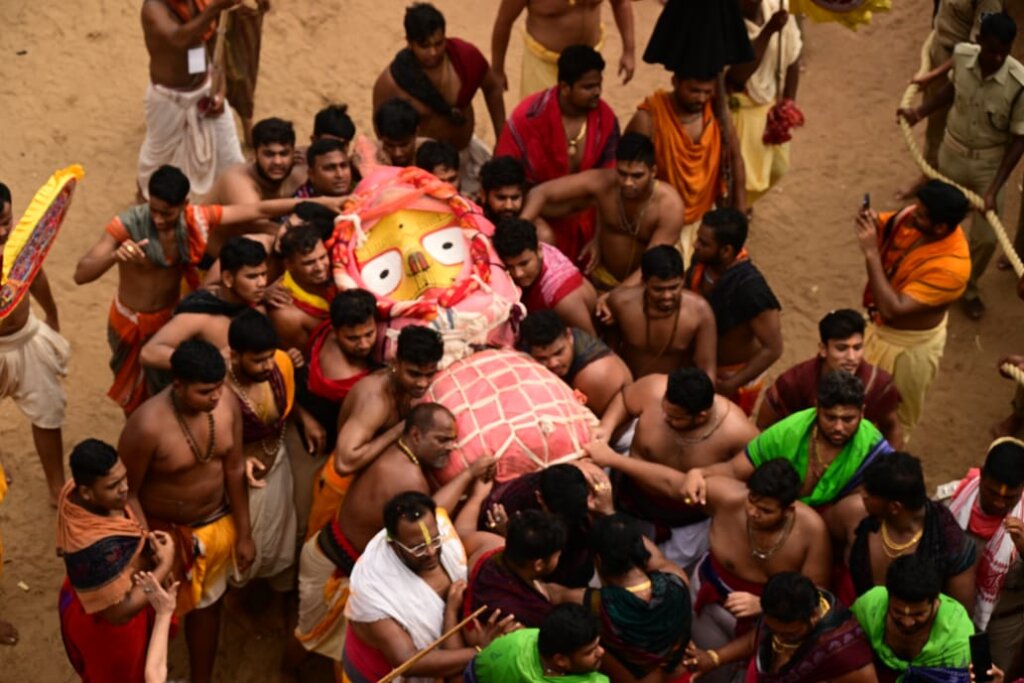
Later, Lord Balabhadra, Devi Subhadra, and Lord Jagannath were led to their separate chariots in ceremonial processions accompanied by gongs, conches, and Jay Jagannath chanting.
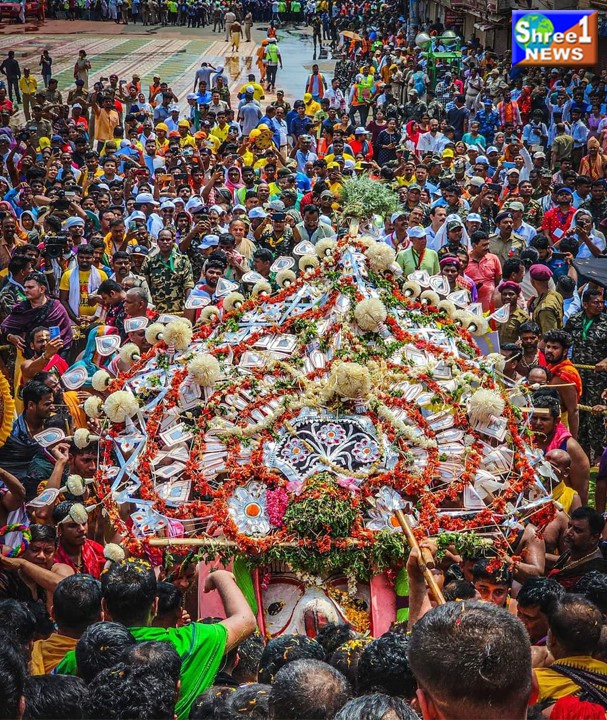
What exactly is Pahandi?
Pahandi is derived from the Sanskrit word Padamundam, which denotes a gradual step-by-step movement with the feet spread in local languages. And Bije refers to a parade of the king or Gods. Pahandi literally means to march forward in a step-by-step motion while multiple devotees beat the ghanta, kahali, and telingi baja.
Pahandi is classified into two types: Dhadi Pahandi and Goti Pahandi.
These chariots stop for a while at the Mausima Temple on their way back. Mausima is also known as the Ardhasani temple, which is dedicated to Lord Jagannath’s aunt. The goddesses in this temple are served ‘Poda Pitha,’ a dessert composed of coconut, rice jaggery, and lentils. The goddesses begin their journey to the main temple after spending some time in Mausima temple. The chariot of Subhadra and Balabhadra continues onward and parks at Singa dwara (Lion’s Gate), while Jagannath’s chariot comes to a halt in front of the King’s Palace.
The Laxmi Narayana Bheta
Lord Jagannath, Goddess Mahalaxmi’s husband, did not take her to Gundicha temple during Car Festival, therefore on Hera Panchami day, Mahalaxmi went to Gundicha temple to visit Lord Jagannath, but he closed the door and did not meet her. Goddess Mahalaxmi was enraged as a result of her crimes, and her anguish continues to this day. She has instructed her servants to notify her as soon as they learn of his return. On Bahuda yatra day, when Nandighosa’s chariot arrives at the King’s palace and Her servants inform Her of Lord Jagannath’s coming, she is eager to see Her husband. Her servants detect her mood and transport Subarna Laxmi (the Goddess Mahalaxmi’s representational idol) in a beautifully decked palanquin to the ‘Chahani Mandapa’. In local Odia language ‘Chahani’ means ‘Glimpse’ and ‘Mandapa’ means ‘Podium’. Chahani Mandapa is the viewing podium situated at the right side of the temple main gate (Lion’s gate). Goddess Mahalakshmi gets a glimpse of the Lord who parked the Nandighosa (His chariot) in front of Srinahara (the King’s palace). In Odia language the exchange of eye to eye look is called ‘Chahani Melana’ (meeting through the eyes).
Goddess Mahalaxmi was angry, but she was also anxious to see her husband. Her servants detect her distress and lead Her palanquin in a parade from Chahani Mandapa to the king’s palace, where the Nandighosa chariot is kept. Lord Balabhadra is Lord Jagannath’s elder brother. In Hindu tradition, the elder brother should not look at or touch the younger brother’s wife. If this happens, it is considered unlucky. As a result, when Goddess Laxmi begins Her journey from Chahani Mandapa, one parada (screen) is placed in front of the Taladhwaja chariot (Lord Balabhadra’s chariot) so that He does not view Goddess Mahalaxmi throughout the procession.
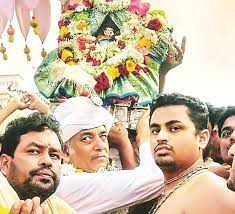
The Gajapati Maharaja (King of Puri) greets Mahalaxmi. Mahalaxi is escorted by the Gajapati King to the Nandighosa chariot. The king offers the Goddess ‘Dahipati Manohi’ (a special prasad provided on this occasion) and carries the Subarna Laxmi statue on his head to meet Lord Jagannath. The Divine pair exchanged glances, and Lord Jagannath offered the Goddess with his ‘Agyan Mala’ (consent garland). After receiving the Agyan Mala, Goddess Mahalaxmi circles the Nandighosa chariot and returns to the temple with Her servants, where she awaits her partner. The ‘Lakshmi Narayana Bheta’ refers to the celestial reunion between Goddess Laxmi and Lord Jagannath. This holy occurrence plainly demonstrates the Deities’ human-like sensibilities.
Following that, the dragging of the Nandighosha chariot from the King’s palace is resumed by thousands of devotees and culminates at the Lion’s gate of Jagannath temple, when the Lord meets His siblings who had already arrived ahead of Him. The Deities remain in their different chariots parked in front of the temple for the Suna Vesha on the day of Bahuda yatra.
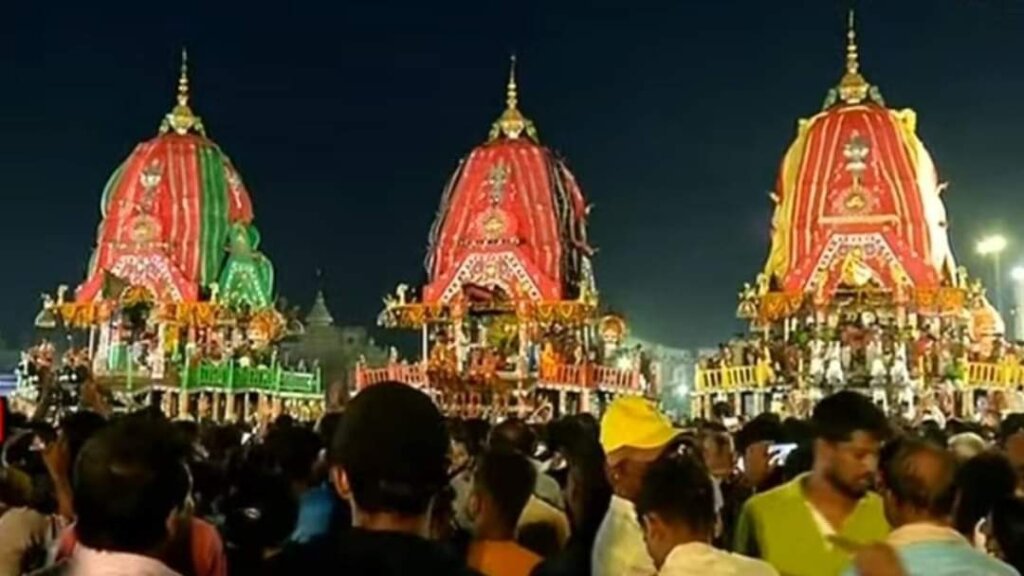
Before the Bahuda Yatra, worshippers flocked to Gundicha temple on a daily basis to offer prayers to the deities and consume Adap abadha (mahaprasad). According to legend, anyone who prays to the deities on Adap Mandap (in the sanctum sanctorum of Gundicha temple atop Ratnasimhasan) gets free from the cycle of rebirth.
—-JAY JAGANNATH—-







 Finance
Finance







